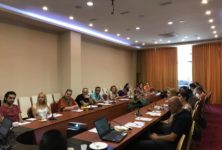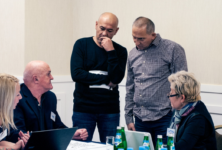Eurasian Harm Reduction Network (EHRN) presents the regional report “Programmatic and Finance Gaps for Key Populations in a Selection of Eastern European and Central Asian Countries,” which covers the financial and programmatic data, barriers and challenges to strengthening the continuum of HIV care in seven countries of the Eastern Europe and Central Asia (EECA) region.
This document was prepared as part of a three-year program entitled “Partnership for equitable access to the HIV care continuum in the Eastern European and Central Asian (EECA) region,” which is being implemented by EHRN and the East Europe and Central Asia Union of People Living with HIV (ECUO). The report was written with the aim of developing a tool to assess the financial landscape for the HIV response for people living with HIV (PLHIV) and key populations at increased risk from HIV in Azerbaijan, Belarus, Estonia, Kazakhstan, the Kyrgyz Republic, the Russian Federation and Uzbekistan. All data were managed by a national consultant in each country.
The main objectives of the report are to identify:
– service coverage and total expenditure for all categories of services within the continuum of HIV and TB care for key populations: people who use drugs (PWUD), men who have sex with men (MSM), and sex workers (SW);
– unit costs for all categories of services within the continuum of HIV and TB care for PLHIV, SW, PWUD and MSM; and
– the funding needed to meet the full demand of key affected populations, how much of that funding can be secured domestically, and the size of the remaining gap that needs to be secured through external funding.
According to Daniel Kashnitsky, the EHRN Program Manager “Partnership for equitable access to the HIV care continuum in the EECA region”: “The data presented in this regional report are valuable not only in providing an overall picture of programmatic coverage and financial gaps across the EECA region but also as a specific tool in a context of a lack of available, detailed expenditure data. Without such underlying data and analysis, countries are unable to budget responsibly for the necessary increases in domestic expenditure that would be involved in scaling up programming, nor are they able to consider the impact of decreasing international donor support for key populations across various elements of the HIV response.”
The report includes recommendations and advocacy messages which highlight the urgent need for all countries to ensure regular analysis of expenditure data to ascertain how much money is being spent on the HIV response, and what it is being spent on. Furthermore, according to the data, significant efforts are also needed to scale up treatment programs and take comprehensive action on voluntary testing and counseling for all key populations, to ensure much more robust linkages to care and enrollment on antiretroviral therapy, and to urgently introduce the viral load technology needed to monitor treatment effectiveness.
* The 90-90-90 targets to end AIDS by 2030 are ambitious UNAIDS treatment targets to help end the AIDS epidemic: by 2020, 90% of all people living with HIV will know their HIV status, 90% of all people with diagnosed HIV infection will receive sustained antiretroviral therapy, and 90% of all people receiving antiretroviral therapy will have viral suppression.
“Partnership for equitable access to the HIV care continuum in the EECA region” is a three-year program, implemented by the East Europe and Central Asia Union of People Living with HIV (ECUO) and the Eurasian Harm Reduction Network (EHRN) with the financial support of the Global Fund to Fight AIDS, Tuberculosis and Malaria. The project’s goal is to enhance the effectiveness, accessibility, sustainability, and scale-up of HIV treatment programs in the EECA region, with a special focus on key populations.


 ПОИСК ПО САЙТУ
ПОИСК ПО САЙТУ  поиск по ресурсному центру
поиск по ресурсному центру 


